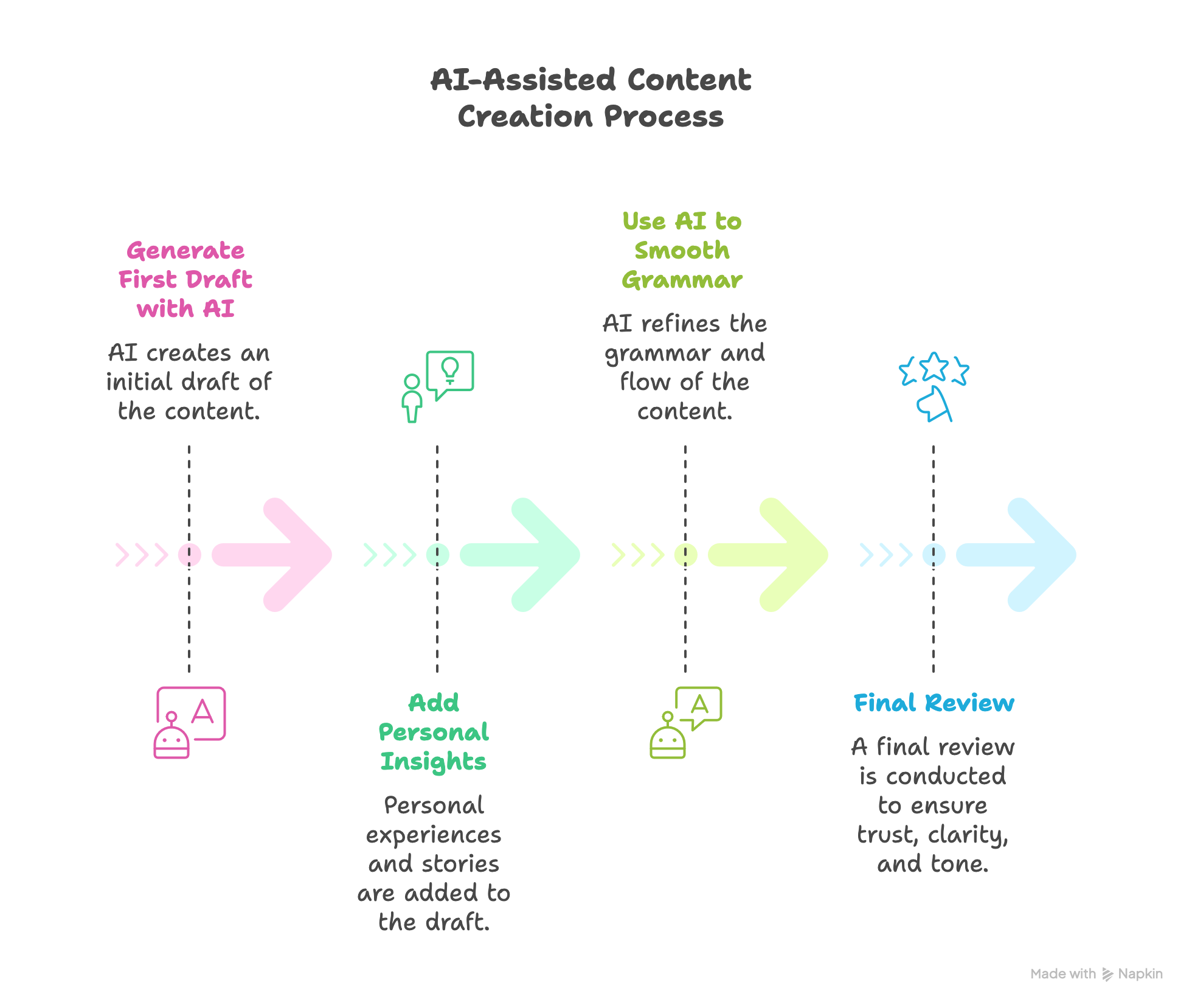AI has reshaped how companies approach content creation. Articles, scripts, social updates, and ad copy can now be produced in seconds. But readers quickly notice when something feels unnatural, and search engines also recognize text that lacks a human touch.
The smart move isn’t to avoid AI, but to use it as a helper. Think of it as a writing assistant, not a ghostwriter.
In this guide, I’ll explain what AI-assisted content is, why businesses rely on it, and how to eliminate the obvious signs that give away machine-written drafts.
What is AI-assisted content?
AI-assisted content is material produced with the help of artificial intelligence tools but shaped by a human editor.
The AI provides the scaffolding: an outline, a draft, or an initial expansion of ideas, while the human injects voice, judgment, and expertise.
Some common uses include:
- Building blog outlines
- Generating alternative titles
- Expanding quick notes into first drafts
- Reworking sentences that feel clumsy
The key distinction: AI speeds up the process, but the writer ensures authenticity and credibility.
Benefits of AI-assisted content for businesses
Why do businesses adopt AI-assisted writing? Several advantages stand out:
- Speed: Drafts that once took hours can be ready in minutes. Teams under tight deadlines can keep pace with demanding content calendars, ensuring campaigns stay on track.
- Cost control: Repetitive writing tasks such as product blurbs or transactional emails no longer consume expensive labor hours. That frees budget for higher-impact projects like storytelling campaigns or strategic experiments.
- Consistency: Large teams often struggle to maintain a steady brand voice across channels. AI provides a baseline style guide, which editors can fine-tune, ensuring every article or ad sounds aligned with brand identity.
- Scalability: Growth often demands more content than human teams can comfortably deliver. AI makes it possible to expand production for seasonal pushes, launches, or SEO projects without overwhelming writers.
When paired with human oversight, AI becomes a force multiplier, letting businesses move faster without losing authenticity.
The hidden risk: AI-writing footprints
AI drafts often carry subtle markers that signal their origin. These traces, known as AI-writing footprints, can damage reader trust and put rankings at risk if the content looks auto-generated.
Think of an article full of vague statements, repetitive phrasing, and rigid flow. Readers sense it’s not written by someone with experience. That impression is what you must avoid.
8 common AI-writing footprints to avoid
Here are the most frequent signs that content came straight from a model:
- Generic filler phrases such as “in today’s world.” They sound polished but add no insight, leaving the reader unsatisfied.
- Overuse of formal connectors like “moreover” or “furthermore.” They create stiff transitions that don’t feel conversational.
- Predictable sentence rhythm with medium-length sentences stacked one after another. This uniformity makes reading dull and unnatural.
- Flat tone that avoids humor, opinion, or strong stances. It feels safe but forgettable, and readers disengage.
- Formatting crutches such as over-reliance on lists or cookie-cutter paragraphs. It signals a formula rather than thoughtful writing.
- Overuse of punctuation as transitions in place of natural sentence flow. This habit looks mechanical and distracting.
- Invented facts where numbers, quotes, or links are fabricated. This damages credibility immediately.
- “It’s not this, it’s that” formulas that try to sound clever but end up feeling cliché. For example: “It’s not about working harder, it’s about working smarter.” When repeated, the trick loses power and sounds artificial.
Spotting and correcting these signs is the first step toward making AI-assisted writing indistinguishable from professional human copy.
Practical strategies to remove AI-writing footprints
Here are ways to refine AI drafts into authentic content:
- Avoid the banned list: Keep a checklist of overused words and phrases commonly generated by AI. Removing them instantly improves authenticity.
- Rewrite with personality: Replace neutral sentences with ones that carry perspective or humor. Small touches of voice are what make writing memorable.
- Add specificity: Back up points with data, anecdotes, or examples. Concrete detail always beats vague generalities.
- Vary sentence structures: Mix short, punchy lines with longer, descriptive passages. Variety mimics natural speech and holds attention.
- Rethink transitions: Don’t force connectors where they aren’t needed. Allow some jumps to feel natural, just like in conversation.
- Check facts manually: Extract every statistic or claim from an AI draft and verify it. Never publish unconfirmed information.
- Read aloud: Hearing your own words exposes stiffness instantly. If it doesn’t sound natural in speech, adjust until it does.
The “Do not use” list
These words and phrases regularly reveal AI-generated text. Keep them off your drafts:
- Conclusion
- Delve
- Digital
- Elevate
- Emerge
- Enhance
- Enigma
- Enrich
- Evolve
- Final thoughts
- Foster
- Furthermore
- Game-changer
- Highlight
- In today’s
- Landscape
- Leverage
- Moreover
- Orchestrate
- Paramount
- Realm
- Seamless
- Skyrocket
- Streamline
- Supercharge
- Tailor
- Tapestry
- Testament
- Unveil
- Vibrant
Use this as a red flag list when editing.
Tip: If you use a custom GPT, you can just make this list a part of the instructions. This way, the AI tool would avoid using these words in the first place, and you won’t have to find and edit them out every time you generate a new piece of content.
Prompt examples for removing AI-writing footprints
Prompts determine the quality of AI output. Use these to clean drafts:
- Rewriting prompt: “Rewrite this in a conversational, natural tone. Remove filler phrases and awkward transitions.”
- Specificity prompt: “Add concrete examples or details that make this section unique.”
- Voice prompt: “Rewrite this in the style of a blogger with 20 years of experience. Make it direct and approachable.”
- Sentence variety prompt: “Change sentence structures so they don’t all follow the same rhythm.”
- Fact-checking prompt: “Extract every statistic or claim from this text and suggest a credible source for each.”
- Editing prompt: “Scan for banned words and replace them with plain, natural alternatives.”
Used together, these prompts refine rough AI drafts into sharp, professional writing.
When to lean on human editing vs. AI rewriting
AI is excellent for structure, grammar, and polishing basics. But only humans can add personal experiences, stories, humor, or cultural references that resonate.
A balanced workflow looks like this:
- Generate a first draft with AI.
- Add personal insights, anecdotes, or stories.
- Use AI again to smooth grammar and flow.
- Do a final review yourself, focusing on trust, clarity, and tone.

This approach combines efficiency with authenticity.
Tools and workflows that help polish AI content
Helpful tools include:
- AI drafting assistants: ChatGPT, Claude, Gemini
- Readability editors: Hemingway, Grammarly
One effective loop is: AI draft → human input → AI polish → fact-check → final human edit.
This workflow produces text that’s fast to create but still credible and engaging.
Wrap-up
AI writing will remain part of modern content creation. The difference lies in execution. If you remove the telltale signs and bring in human judgment, your writing feels alive and trustworthy.
Treat AI as a helper. Let it speed up the process, but never hand it complete control.
Pairing efficiency with human perspective results in content that resonates with readers and strengthens brand authority.
